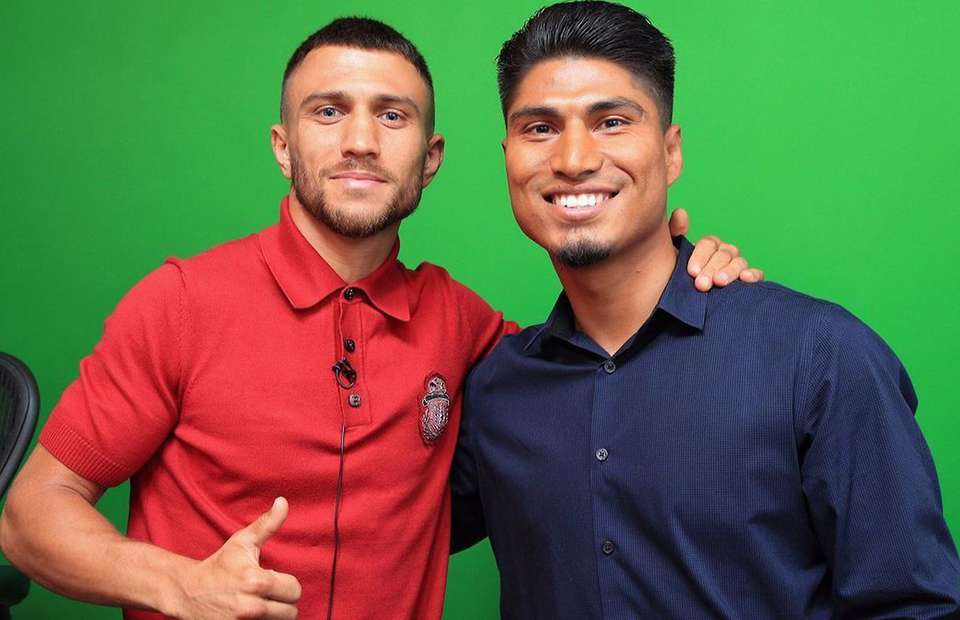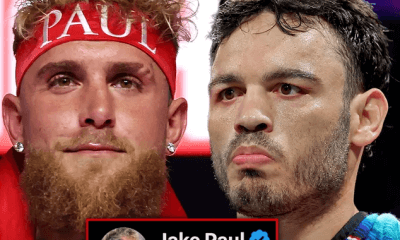Featured Articles
Is the ‘Mayweather Factor’ Stalling the Garcia-Lomachenko Fight?

Since WBC/IBF lightweight champ Mikey Garcia soundly defeated IBF titlist Robert Easter, many have been speculating as to why he’s been very guarded talking about WBA title holder Vasyl Lomachenko, his only rival holding a title at 135. A fight between Mikey and Lomachenko for the undisputed lightweight title (assuming Lomachenko beats WBO title holder Jose Pedraza in December) would be the most anticipated lightweight title bout in ages. More than 50 years have elapsed since the last true super fight at lightweight.
As it was stated in this space on July 29th, it looks like, at least from afar, that Garcia has some trepidation pertaining to a showdown with Lomachenko. This is night and day different from saying Garcia actually fears Lomachenko; no, I don’t believe that. And if they were to meet I see it as a 50-50 fight with both presenting the other more questions stylistically than any other opponent they’ve ever faced, with a slight lean to Lomachenko presenting Mikey with a little bigger headache than the reverse.
In Garcia’s defense, for financial and other reasons, there is a strong case for him wanting to drag his feet regarding Lomachenko for as long as he can. And it could be that when he dropped Errol Spence’s name it was only a ruse.
Consider this: Mikey being 30 years old is/was no doubt most influenced by Floyd Mayweather, the most successful fighter financially in boxing history. Garcia learned by watching Mayweather that it doesn’t matter what’s said in the media as long as your name is continually in front of the fans. He watched Mayweather be accused of fearing Manny Pacquiao while being labeled a cherry picker. Floyd didn’t care, he continued to face fighters whose best days had come and gone. Mikey witnessed Floyd tease fans for over five years about fighting Pacquiao and then when the money was near its high water mark and Manny had been knocked out by Juan Manuel Marquez after enduring some strenuous fights, Floyd finally gave it the go-ahead and he and Manny both were paid more for one fight than Muhammad Ali and Sugar Ray Leonard made during their entire careers.
Understanding the above, it’s easy to glean why Garcia doesn’t care if fans and some in the boxing media accuse him of fearing Lomachenko. What he knows for sure is that those same people will be there in droves when he finally does face him. He knows — in much the same way that Mayweather viewed Pacquiao — that this is the fight that fight fans want to see, so unless one gets knocked off before they meet, the fight will always be there. Floyd knew Manny would never decline it after he had strung him along for five-plus years.
Mikey Garcia doesn’t just have one of the highest boxing IQ’s of any active fighter in the ring, he’s no one’s fool out of it pertaining to the business side of boxing and that’s probably why, like Floyd, he left Bob Arum. He’s fully cognizant that he’s never fought on PPV and that is where the big money is. He also observes how some fighters have the media and the establishment behind them. Lomachenko is exhibit A.
Here’s a fighter in Lomachenko who has more experience than his 11-1 (9) record indicates and probably boxed more rounds getting ready for his 397 amateur bouts than Garcia has in his 39 pro bouts. And the funny thing is Lomachenko fought six fights in the “World Series of Boxing.” These fights, amateur in name only, were scheduled for five rounds, one more than the four rounders that entry level pros fight. But saying Lomachenko has won three titles in different divisions in just 12 bouts makes him a bigger monster and star than adding the six bouts before his debut, which would make him 17-1.
Stylistically Garcia is a fundamental boxer. He isn’t flashy, just super-efficient. Purists marvel at him but how many of them are around today? Lomachenko, who looks unlike other fighters past or present, is much better eye candy. Actually he’s sort of a hybrid of Hector Camacho and Pernell Whitaker. And he has the ring presence of a smaller Muhammad Ali. In other words, Lomachenko looks as if he’s in control when nothing is transpiring during a round, and whenever he does do something, it grabs your attention and influences the judges and many fans too.
Another issue Garcia might have is that he probably knows going in that he won’t get any of the borderline rounds since Lomechenko is perceived as the bigger star. More than likely, Garcia feels that he has to stop him to come out with the win and that certainly isn’t something he can bank on.
Lomachenko’s style is rooted more in athleticism and speed than boxing brilliance. Vasyl breaks a lot of rules and as he ages, his effectiveness — like Ali and Roy Jones — will decline. Conversely, Garcia’s supreme fundamentals and technique travel better with age. And with both being 30 years old, Mikey is the one who just may have more years ahead of him fighting near his peak. So the longer he keeps the fight from happening, the more it works in his favor.
The reasons for Garcia acting as if Lomachenko doesn’t exist don’t in any way indicate fear on his part. Mikey surely knows that Lomachenko is a very tough man for him to fight stylistically, but it’s not like he cannot be decoded and if there was a fighter at or near Vasyl’s weight to crack his code, it’s Garcia. But it’s a tough fight, and knowing that all the close calls will go to Lomachenko, Mikey needs to be paid like he’s never been paid before.
It’s plausible Mikey knows the fight with Lomachenko isn’t going to disappear. So it makes sense for him to “Mayweather” it, allowing it to be said he’s fearful of Vasyl as he strings it along. And when the money is right and he feels he’s leveled everything outside the ring as much as he can – then he’ll okay it.
One thing is for sure, Garcia is the more accomplished pro and at age 30 he’s covered more ground than Lomachenko has. Mikey has more leverage fighting Lomachenko than Deontay Wilder does fighting Anthony Joshua. Unlike Wilder, Garcia shouldn’t agree to anything less than a 50-50 purse split, whereas Wilder should kiss the ground if he can get 40 percent when he fights Joshua.
No, Mikey Garcia doesn’t lose sleep over Vasyl Lomachenko – he just believes he’s probably not going to get a level playing field going in without playing games, mixed in with a little subterfuge and actually fighting at the bargaining table. My feeling is when Garcia is confident he’s worked out the best deal he can and maybe Loma has eroded slightly – we’ll see maybe the biggest lightweight championship fight ever with all the meaningful hardware on the line.
Super fights in the lightweight division have been few and far between. Garcia-Lomachenko just could be the most anticipated lightweight title fight ever and if it never comes to fruition I sincerely doubt Mikey Garcia will be the reason. Those who have followed boxing for a long time know it’s just not a matter of two guys wanting to face each other. Gamesmanship and leverage have always been a part of boxing. Floyd Mayweather took it to a new level and it’s hard not to believe his influence isn’t in play here regarding Garcia’s approach to fighting Lomachenko.
It’s really shortsighted to think Mikey fears Vasyl, but it’s not bad business to let fight fans believe it.
Between 1977 and 1982, Frank Lotierzo had over 50 fights in the middleweight division. He trained at Joe Frazier’s gym in Philadelphia under the tutelage of the legendary George Benton. Before joining The Sweet Science his work appeared in several prominent newsstand and digital boxing magazines and he hosted “Toe-to-Toe” on ESPN Radio. Lotierzo can be contacted at GlovedFist@gmail.com
Check out more boxing news on video at The Boxing Channel
-

 Featured Articles4 weeks ago
Featured Articles4 weeks agoAvila Perspective, Chap. 330: Matchroom in New York plus the Latest on Canelo-Crawford
-

 Featured Articles3 weeks ago
Featured Articles3 weeks agoVito Mielnicki Jr Whitewashes Kamil Gardzielik Before the Home Folks in Newark
-

 Featured Articles17 hours ago
Featured Articles17 hours agoResults and Recaps from New York Where Taylor Edged Serrano Once Again
-

 Featured Articles4 weeks ago
Featured Articles4 weeks agoCatching Up with Clay Moyle Who Talks About His Massive Collection of Boxing Books
-

 Featured Articles5 days ago
Featured Articles5 days agoFrom a Sympathetic Figure to a Pariah: The Travails of Julio Cesar Chavez Jr
-

 Featured Articles3 weeks ago
Featured Articles3 weeks agoMore Medals for Hawaii’s Patricio Family at the USA Boxing Summer Festival
-

 Featured Articles7 days ago
Featured Articles7 days agoCatterall vs Eubank Ends Prematurely; Catterall Wins a Technical Decision
-

 Featured Articles4 weeks ago
Featured Articles4 weeks agoRichardson Hitchins Batters and Stops George Kambosos at Madison Square Garden




















